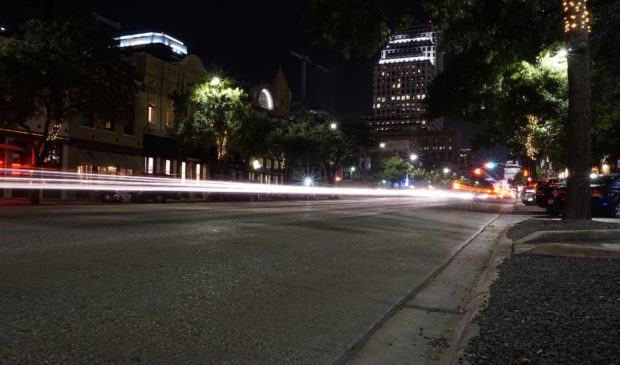Report spells out Congress Avenue’s potential transformation
Tuesday, August 22, 2017 by
Chad Swiatecki The future of Congress Avenue leading up to the state Capitol could see bicycles claiming the middle of the road as cars pass on both sides. That is one configuration in the discussion for an eventual makeover of the street from Riverside Drive to 11th Street, in a bid to turn the outdated and somewhat uninviting street into “the Main Street of Texas.”
A progress report on the Congress Avenue Urban Design Initiative came at last week’s Downtown Commission meeting, with city staff reporting that public tours and focus groups found the public sees the street as flawed and not living up to its potential in one of the nation’s fastest-growing cities. Workers from the Downtown Austin Alliance and consultants hired to work on the project are still analyzing more than 500 comments from those sessions but themes that have emerged include criticism that the streetscape has irregular physical terrain and lacks a cohesive physical environment and solid vision.
The study also found that the ground-floor retail environment between Seventh and 11th streets has a vacancy rate of 25 percent, which is abnormal for a district quickly adding residential development and a ZIP code projected to add up to 30,000 residents by 2040.
Last week’s presentation comes ahead of an expected delivery of design options for the district from Boston-based Sasaki Associates, with public comment on those suggestions open until the end of October. It is expected the city will adopt a final vision document for Congress Avenue in spring 2018, which will allow city staff to incorporate related construction into scheduled projects and identify funding sources for more ambitious work.
Lizzy Smith, a senior planner of urban design for the city’s Planning and Zoning Department, said Congress Avenue is showing its age and needs to become more inviting for pedestrians and bicycles while also serving vehicular traffic.
“Congress Avenue has not been redesigned in about 30 years and the city has changed a lot in those years, but you’ve still got five lanes dedicated to traffic and small pedestrian sidewalks,” she said. “A positive is that the district has a really good block structure, and you could see access streets being dedicated to take certain (vehicle) flow, with Congress serving as the spine of a larger network of streets.”
Smith said some of the most critical safety points include the intersections at Cesar Chavez Street and Riverside Drive and the nightly crowds gathered on the Ann W. Richards Congress Avenue Bridge to watch the bats fly out at dusk.
While there is no timeline for when the street renovation will be complete, Michele Van Hyfte, vice president of economic development for the Downtown Austin Alliance, said the public sees untapped potential in the district and wants it to be more of a community gathering area throughout the year.
“We hope that we can draw people there and have it serve as a destination where people of Austin and all of Texas feel it’s welcoming and accessible,” she said. “People feel that it should be a place to celebrate, and have more of a feel that’s connected to the history of the city and the state.”
Van Hyfte said the improvements likely to be made first will be infrastructure work to make the area more accessible for those with disabilities, followed by adding healthy tree cover and updating lighting and signage.
She also said city staff needs to make the district’s improvement a priority so that its findings don’t get forgotten, leaving it stagnant as more residents and businesses move in over the coming decades.
“The city has an important role in making sure this is implemented, and public works is fully committed to the long game on this, so the street looks the way the final design concept spells out,” she said. “The DAA has served as an active partner in this, and we are fully committed going forward.”
The Congress Avenue plan would also link up with the 2016 Texas Capitol Complex Master Plan, which focuses on the Capitol grounds between 15th Street and Martin Luther King Jr. Boulevard and would add green space, remove cars and see up to 5 million square feet of new building space constructed.
Photo by Spawnzilla (Own work) [CC BY-SA 4.0], via Wikimedia Commons.
The Austin Monitor’s work is made possible by donations from the community. Though our reporting covers donors from time to time, we are careful to keep business and editorial efforts separate while maintaining transparency. A complete list of donors is available here, and our code of ethics is explained here.
You're a community leader
And we’re honored you look to us for serious, in-depth news. You know a strong community needs local and dedicated watchdog reporting. We’re here for you and that won’t change. Now will you take the powerful next step and support our nonprofit news organization?









